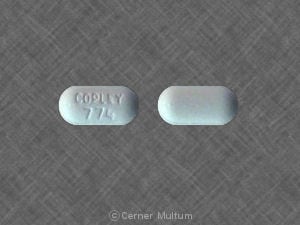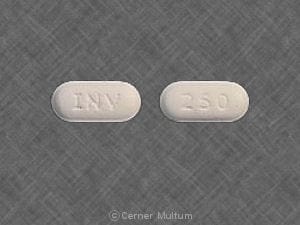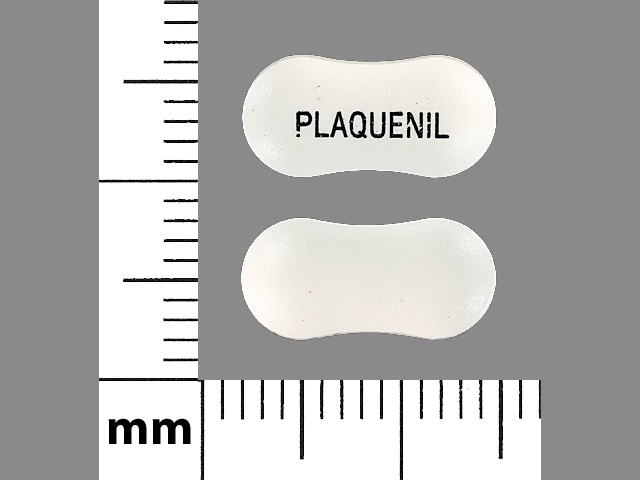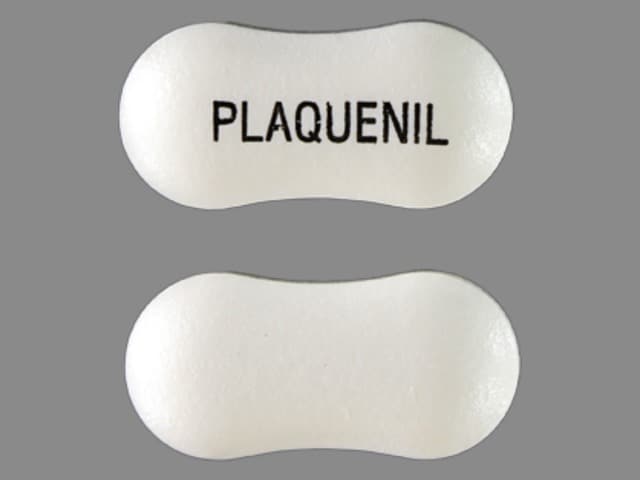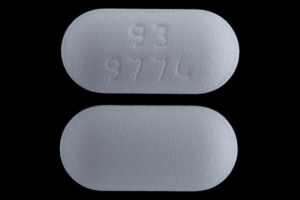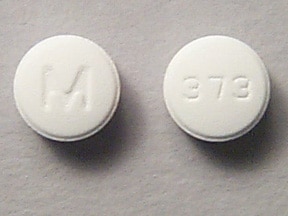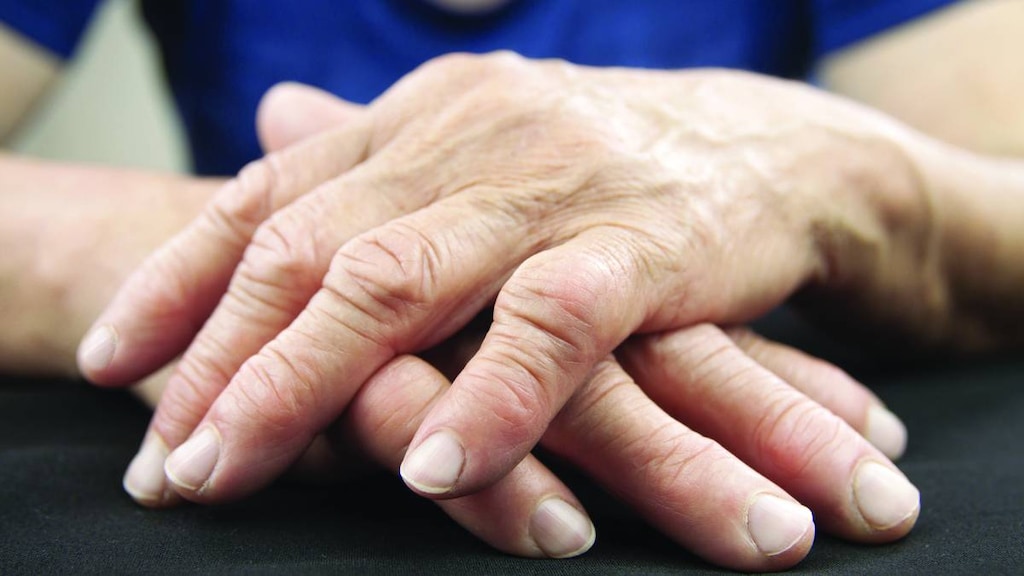Dosage Forms
Excipient information presented when available (limited, particularly for generics); consult specific product labeling.
Tablet, Oral, as sulfate:
Plaquenil: 200 mg
Generic: 200 mg
Pharmacology
Mechanism of Action
Interferes with digestive vacuole function within sensitive malarial parasites by increasing the pH and interfering with lysosomal degradation of hemoglobin; inhibits locomotion of neutrophils and chemotaxis of eosinophils; impairs complement-dependent antigen-antibody reactions
Pharmacokinetics/Pharmacodynamics
Absorption
Incomplete and variable (~70% [range: 25 to 100%]) (Tett 1993)
Metabolism
Hepatic; metabolites include bidesethylchloroquine, desethylhydroxychloroquine, and desethylchloroquine (McChesney 1966)
Excretion
Urine (15% to 25% [Tett 1993]; as metabolites and unchanged drug [up to 60%, McChesney 1966]); may be enhanced by urinary acidification
Onset of Action
Rheumatic disease: May require several weeks to respond
Half-Life Elimination
~40 days (Tett 1993)
Protein Binding
~40%, primarily albumin (Tett 1993)
Use: Labeled Indications
Lupus erythematosus: Treatment of chronic discoid erythematosus and systemic lupus erythematosus in adults.
Malaria: Treatment of uncomplicated malaria caused by susceptible strains of Plasmodium vivax, Plasmodium malariae, Plasmodium ovale, and Plasmodium falciparum; prophylaxis of malaria in geographic areas where chloroquine resistance is not reported.
Limitations of use: Hydroxychloroquine is not effective against chloroquine- or hydroxychloroquine-resistant malaria strains of Plasmodium species; not recommended for treatment of complicated malaria, malaria prophylaxis in regions with chloroquine resistance, or treatment when the Plasmodium species has not been identified; hydroxychloroquine does not prevent relapses of P. vivax and P. ovale infections because it is not effective against the hypnozoite forms of these parasites.
Rheumatoid arthritis: Treatment of acute and chronic rheumatoid arthritis in adults.
Use: Off Label
Dermatomyositis, cutaneous diseasec
Data from case reports and retrospective and open-label studies support the use of hydroxychloroquine in the treatment of cutaneous manifestations of dermatomyositis Cosnes 1995, Olson 1989, Woo 1984.
Porphyria cutanea tardac
Data from a randomized, nonblinded pilot study support the use of hydroxychloroquine in the treatment of porphyria cutanea tarda Singal 2012.
Primary Sjögren syndrome (extraglandular manifestations)c
Data from small noncontrolled studies have suggested benefit of hydroxychloroquine in the treatment of myalgia and arthralgia (extraglandular symptoms) of primary Sjögren syndrome. However, randomized, placebo-controlled trials demonstrated no significant improvement in symptoms associated with Sjögren syndrome, including fatigue and chronic pain. Inconsistent criteria for patient inclusion and patient response, small numbers of patients, and the abbreviated study length of some of the published studies may have contributed to the conflicting results.
Q fever (Coxiella burnetii)yes
Based on the Centers for Disease Control and Prevention (CDC) recommendations for the diagnosis and management of Q fever (Coxiella burnetii), hydroxychloroquine (in combination with doxycycline) is effective and recommended for the treatment of chronic Q fever.
Sarcoidosis, arthropathyc
Clinical experience supports the use of hydroxychloroquine in the treatment of sarcoid arthropathy ASG [Agarwal] 2018, Sequeira 2019.
Sarcoidosis, cutaneous disease (extensive)c
Data from case series and retrospective and open-label studies support the use of hydroxychloroquine in the treatment of extensive cutaneous sarcoidosis Chong 2005, Jones 1990, Modi 2008.
Contraindications
Known hypersensitivity to hydroxychloroquine, 4-aminoquinoline derivatives, or any component of the formulation.
Canadian labeling: Additional contraindications (not in the US labeling): Preexisting retinopathy; use in children <6 years or weighing <35 kg
Dosage and Administration
Dosing: Adult
Note: Safety: To avoid retinopathy and permanent vision loss, do not exceed recommended maximum doses. Baseline and periodic screening for retinopathy is necessary for rheumatologic uses and in long-term therapy (eg, >1 to 5 years depending on patient risk factors) (AAO [Marmor 2016]; Travassos 2019). Tolerability: GI upset (nausea, vomiting, diarrhea) is a common adverse effect. Dividing doses, taking with food, and, if appropriate, gradual dose escalation (in treating rheumatologic diseases) may improve tolerability (Wallace 2019). Dosage forms: Variable daily dosing (eg, alternating or skipping doses on certain days each week) may be used to obtain the recommended dose for rheumatologic uses. All doses below are expressed as hydroxychloroquine sulfate salt. Hydroxychloroquine sulfate salt 200 mg is equivalent to hydroxychloroquine base 155 mg.
Dermatomyositis, cutaneous disease (off-label use): Note: Used in combination with antipruritic medications, topical therapy, and nonpharmacologic measures (eg, photoprotection) (Miller 2019; Vleugels 2019).
Oral: 300 to 400 mg daily as a single daily dose or in 2 divided doses. Assess response after 3 months; may attempt to slowly taper after several months of satisfactory response (Ang 2005; James 1985; Miller 2019; Vleugels 2019; Woo 1984). Note: Due to the risk of retinal toxicity, most patients should not receive a daily dose >5 mg/kg/day using actual body weight or 400 mg, whichever is lower (AAO [Marmor 2016]; Melles 2014; Petri 2019; Wallace 2019; manufacturer's labeling).
Lupus erythematosus:
Systemic lupus erythematosus: Note: In general, hydroxychloroquine (or chloroquine) is indicated for all patients with systemic disease; additional therapy is individualized according to predominant disease manifestations and activity (Lam 2016; Tsang-A-Sjoe 2015; Wallace 2019).
Oral: 200 to 400 mg daily as a single daily dose or in 2 divided doses. Note: Due to the risk of retinal toxicity, most patients should not receive a daily dose >5 mg/kg/day using actual body weight or 400 mg, whichever is lower (AAO [Marmor 2016]; Melles 2014; Petri 2019; Wallace 2019; manufacturer's labeling).
Discoid lupus erythematosus and subacute cutaneous lupus erythematosus: For use if response to local therapy is inadequate or impractical due to widespread skin lesions (Clarke 2019; Kuhn 2017):
Oral: 200 to 400 mg daily as a single daily dose or in 2 divided doses. Note: Due to the risk of retinal toxicity, most patients should not receive a daily dose >5 mg/kg/day using actual body weight or 400 mg, whichever is lower (AAO [Marmor 2016]; Melles 2014; Petri 2019; Wallace 2019; manufacturer's labeling).
Malaria:
Chemoprophylaxis: Note: Only for use in individuals traveling to malarious regions without chloroquine resistance (CDC 2018).
Oral: 400 mg once weekly on the same day each week; begin 1 to 2 weeks before travel to malarious area; continue therapy while in malarious area and for 4 weeks after leaving the area (CDC 2018).
Treatment, uncomplicated: Note: Only for treatment of nonsevere infections caused by chloroquine-sensitive malaria; for infection caused by Plasmodium vivax or Plasmodium ovale, give as part of an appropriate combination regimen. Not recommended for treatment if chloroquine or hydroxychloroquine was given for chemoprophylaxis (CDC 2019; WHO 2015).
Oral: 800 mg once, followed by 400 mg at 6, 24, and 48 hours after initial dose (total dose: 2 g) (CDC 2019; WHO 2015).
Porphyria cutanea tarda (off-label use): Oral: 100 mg twice weekly; continue until plasma or urine porphyrin levels are normal for at least several months (Singal 2012; Singal 2019).
Primary Sjögren syndrome (off-label use): Note: For treatment of moderate to severe extraglandular manifestations (eg, arthralgias, myalgias, fatigue) or milder symptoms unresponsive to nonpharmacologic measures and nonsteroidal anti-inflammatory drugs (NSAIDs) (Carsons 2017; Demarchi 2017; Fox 1996; Kruize 1993; Mavragani 2006); some experts also use in patients with major salivary enlargement resulting in cosmetic concerns or glandular pain (Baer 2019).
Oral: Initial: 200 to 400 mg daily as a single daily dose or in 2 divided doses (Gottenberg 2014; Kruize 1993; Mavragani 2006). Note: Due to the risk of retinal toxicity, most patients should not receive a daily dose >5 mg/kg/day using actual body weight or 400 mg, whichever is lower (AAO [Marmor 2016]; Melles 2014; Petri 2019; Wallace 2019; manufacturer's labeling).
Q fever (Coxiella burnetii) (off-label use):
Persistent localized infection (eg, endocarditis, osteomyelitis, vascular infection, prosthetic joint infection) in nonpregnant patients: Oral: 600 mg/day in 1 or 3 divided doses in combination with doxycycline for ≥18 months, depending on site of infection and serologic response; in prosthetic valve disease or vascular infection, extend treatment to ≥24 months (CDC [Anderson 2013]; Raoult 2019).
Prevention of persistent infection following acute Q fever: Note: Generally reserved for patients with valvulopathy/cardiomyopathy (CDC [Anderson 2013]; Million 2013; Raoult 2019) or postpartum women with persistent serologic evidence of infection >12 months after delivery (CDC [Anderson 2013]).
Oral: 600 mg/day in 1 or 3 divided doses in combination with doxycycline for 12 months (CDC [Anderson 2013]; Million 2013; Raoult 2019).
Rheumatoid arthritis: Note: May be used as monotherapy (alternative agent) in patients with mild or limited disease without poor prognostic factors. May also be used in patients with moderate to severe disease regardless of prognostic factors in combination with other nonbiologic disease-modifying antirheumatic drugs (ACR [Singh 2016]; EULAR [Smolen 2014]; Kumar 2013; O’Dell 2013; Rath 2010; Smolen 2016).
Oral: 200 to 400 mg daily as a single daily dose or in 2 divided doses (Kumar 2013). Note: Due to the risk of retinal toxicity, most patients should not receive a daily dose >5 mg/kg/day using actual body weight or 400 mg, whichever is lower (AAO [Marmor 2016]; Melles 2014; Petri 2019; Wallace 2019; manufacturer's labeling).
Sarcoidosis (off-label use):
Arthropathy: Note: As additional therapy for NSAID-resistant symptoms in patients with an inadequate response to glucocorticoids or who are unable to fully taper (ASG [Agarwal] 2018; Sequeira 2019).
Oral: 200 to 400 mg daily as a single daily dose or in 2 divided doses. Therapy may be continued for ~1 year and then gradually tapered in patients who have responded and are stable on therapy (Sequeira 2019). Note: Due to the risk of retinal toxicity, most patients should not receive a daily dose >5 mg/kg/day using actual body weight or 400 mg, whichever is lower (AAO [Marmor 2016]; Melles 2014; Petri 2019; Wallace 2019; manufacturer's labeling).
Cutaneous disease, extensive: Oral: 200 to 400 mg daily as a single daily dose or in 2 divided doses for ≥3 months to evaluate for efficacy; if there is satisfactory improvement, may consider gradual tapering and discontinuation if response is maintained (Modi 2008; Prystowsky 2019). Note: Due to the risk of retinal toxicity, most patients should not receive a daily dose >5 mg/kg/day using actual body weight or 400 mg, whichever is lower (AAO [Marmor 2016]; Melles 2014; Petri 2019; Wallace 2019; manufacturer's labeling).
Dosing: Geriatric
Refer to adult dosing.
Dosing: Pediatric
Note: All doses below expressed as hydroxychloroquine sulfate. Hydroxychloroquine sulfate 200 mg is equivalent to 155 mg hydroxychloroquine base.
Malaria:
Chemoprophylaxis: Infants, Children, and Adolescents: Oral: 6.5 mg/kg hydroxychloroquine sulfate once weekly on the same day each week; maximum dose: 400 mg/dose hydroxychloroquine sulfate; begin 1 to 2 weeks before exposure; continue for at least 4 weeks after leaving endemic area (CDC 2016). If the initiation of chemoprophylaxis is delayed (ie, 2 weeks of therapy not completed prior to the exposure), the manufacturer recommends initiating therapy by doubling the initial dose (13 mg/kg of hydroxychloroquine sulfate) and administering in 2 divided doses 6 hours apart; maximum single dose: 400 mg/dose hydroxychloroquine sulfate; continue for 8 weeks after leaving endemic area.
Treatment; acute attack; uncomplicated: Infants, Children, and Adolescents: Oral: Initial: 13 mg/kg/dose hydroxychloroquine sulfate (maximum initial dose: 800 mg/dose hydroxychloroquine sulfate); followed by 6.5 mg/kg hydroxychloroquine sulfate at 6, 24, and 48 hours after initial dose; maximum dose: 400 mg/dose hydroxychloroquine sulfate (CDC 2013)
JRA or SLE: Oral: 3 to 5 mg/kg/day divided 1 to 2 times/day to a maximum of 400 mg/day; not to exceed 7 mg/kg/day
Dosing: Obesity
Rheumatic diseases (eg, rheumatoid arthritis, lupus erythematosus, primary Sjögren syndrome [off-label use]): Available data do not specifically address dosing in obese patients; however, some experts recommend standard daily doses (non-weight-based) up to a maximum of 400 mg/day in patients weighing ≥80 kg (Wallace 2019).
Extemporaneously Prepared
A 25 mg/mL hydroxychloroquine sulfate oral suspension may be made with tablets. With a towel moistened with alcohol, remove the coating from fifteen 200 mg hydroxychloroquine sulfate tablets. Crush tablets in a mortar and reduce to a fine powder. Add 15 mL of Ora-Plus and mix to a uniform paste; add an additional 45 mL of vehicle and mix until uniform. Mix while adding sterile water for irrigation in incremental proportions to almost 120 mL; transfer to a calibrated bottle, rinse mortar with sterile water, and add sufficient quantity of sterile water to make 120 mL. Label "shake well". A 30-day expiration date is recommended, although stability testing has not been performed.
Pesko LJ, "Compounding: Hydroxychloroquine," Am Druggist, 1993, 207(4):57.
Administration
Administer with food or milk. Do not crush or divide film-coated tablets.
Storage
Store at 20°C to 25°C (68°F to 77°F); excursions permitted to 15°C to 30°C (59°F to 86°F). Protect from light.
Hydroxychloroquine Images
Drug Interactions
Androgens: May enhance the hypoglycemic effect of Blood Glucose Lowering Agents. Exceptions: Danazol. Monitor therapy
Antidiabetic Agents: May enhance the hypoglycemic effect of Hypoglycemia-Associated Agents. Monitor therapy
Antipsychotic Agents (Phenothiazines): Antimalarial Agents may increase the serum concentration of Antipsychotic Agents (Phenothiazines). Monitor therapy
Artemether: May enhance the adverse/toxic effect of Antimalarial Agents. Management: Artemether/Lumefantrine (combination product) should not be used with other antimalarials unless there is no other treatment option. Avoid combination
Beta-Blockers: Aminoquinolines (Antimalarial) may decrease the metabolism of Beta-Blockers. Exceptions: Atenolol; Carteolol (Ophthalmic); Levobunolol; Metipranolol; Nadolol; Sotalol. Monitor therapy
Cardiac Glycosides: Aminoquinolines (Antimalarial) may increase the serum concentration of Cardiac Glycosides. Monitor therapy
Citalopram: May enhance the hypoglycemic effect of Hydroxychloroquine. Hydroxychloroquine may enhance the QTc-prolonging effect of Citalopram. Monitor therapy
Dapsone (Systemic): Antimalarial Agents may enhance the adverse/toxic effect of Dapsone (Systemic). Specifically, concomitant use of antimalarial agents with dapsone may increase the risk of hemolytic reactions. Dapsone (Systemic) may enhance the adverse/toxic effect of Antimalarial Agents. Specifically, concomitant use of dapsone with antimalarial agents may increase the risk for hemolytic reactions. Management: Closely monitor patients for signs/symptoms of hemolytic reactions with concomitant use of dapsone and antimalarial agents, particularly in patients deficient in glucose-6-phosphate dehydrogenase (G6PD), methemoglobin reductase, or with hemoglobin M. Consider therapy modification
Dapsone (Topical): Antimalarial Agents may enhance the adverse/toxic effect of Dapsone (Topical). Specifically, the risk of hemolytic reactions may be increased. Management: Closely monitor for signs/symptoms of hemolytic reactions with concomitant use of topical dapsone and antimalarial agents. Patients with glucose-6-phosphate dehydrogenase deficiency may be at particularly high risk for adverse hematologic effects. Consider therapy modification
Escitalopram: May enhance the hypoglycemic effect of Hydroxychloroquine. Hydroxychloroquine may enhance the QTc-prolonging effect of Escitalopram. Monitor therapy
Haloperidol: QT-prolonging Agents (Indeterminate Risk - Avoid) may enhance the QTc-prolonging effect of Haloperidol. Monitor therapy
Herbs (Hypoglycemic Properties): May enhance the hypoglycemic effect of Hypoglycemia-Associated Agents. Monitor therapy
Hypoglycemia-Associated Agents: May enhance the hypoglycemic effect of other Hypoglycemia-Associated Agents. Monitor therapy
Lumefantrine: Antimalarial Agents may enhance the adverse/toxic effect of Lumefantrine. Management: Artemether/Lumefantrine (combination product) should not be used with other antimalarials unless there is no other treatment option. Avoid combination
Maitake: May enhance the hypoglycemic effect of Blood Glucose Lowering Agents. Monitor therapy
Mefloquine: Aminoquinolines (Antimalarial) may enhance the adverse/toxic effect of Mefloquine. Specifically, the risk for QTc-prolongation and the risk for convulsions may be increased. Mefloquine may increase the serum concentration of Aminoquinolines (Antimalarial). Management: Avoid concurrent use, and delay administration of mefloquine until at least 12 hours after the last dose of an aminoquinoline antimalarial when possible. Avoid combination
Monoamine Oxidase Inhibitors: May enhance the hypoglycemic effect of Blood Glucose Lowering Agents. Monitor therapy
Pegvisomant: May enhance the hypoglycemic effect of Blood Glucose Lowering Agents. Monitor therapy
Prothionamide: May enhance the hypoglycemic effect of Blood Glucose Lowering Agents. Monitor therapy
QT-prolonging Agents (Highest Risk): QT-prolonging Agents (Indeterminate Risk - Avoid) may enhance the QTc-prolonging effect of QT-prolonging Agents (Highest Risk). Management: Monitor for QTc interval prolongation and ventricular arrhythmias when these agents are combined. Patients with additional risk factors for QTc prolongation may be at even higher risk. Monitor therapy
Quinolones: May enhance the hypoglycemic effect of Blood Glucose Lowering Agents. Quinolones may diminish the therapeutic effect of Blood Glucose Lowering Agents. Specifically, if an agent is being used to treat diabetes, loss of blood sugar control may occur with quinolone use. Monitor therapy
Salicylates: May enhance the hypoglycemic effect of Blood Glucose Lowering Agents. Monitor therapy
Selective Serotonin Reuptake Inhibitors: May enhance the hypoglycemic effect of Blood Glucose Lowering Agents. Monitor therapy
Tamoxifen: May enhance the adverse/toxic effect of Hydroxychloroquine. Specifically, concomitant use of tamoxifen and hydroxychloroquine may increase the risk of retinal toxicity. Monitor therapy
Adverse Reactions
1% to 10%: Ophthalmic: Retinopathy (4%; serum concentration dependent [Petri 2019]; early changes reversible [may progress despite discontinuation if advanced])
Frequency not defined:
Central nervous system: Ataxia, dizziness, emotional disturbance, emotional lability, headache, irritability, lassitude, nervousness, nightmares, psychosis, seizure, sensorineural hearing loss, suicidal tendencies, vertigo
Dermatologic: Acute generalized exanthematous pustulosis, alopecia, bleaching of hair, bullous rash, dyschromia (skin and mucosal; black-blue color), erythema multiforme, erythema of skin (annulare centrifugum), exacerbation of psoriasis (nonlight sensitive), exfoliative dermatitis, lichenoid eruption, maculopapular rash, morbilliform rash, pruritus, skin photosensitivity, Stevens-Johnson syndrome, toxic epidermal necrolysis, urticaria
Endocrine & metabolic: Exacerbation of porphyria, weight loss
Gastrointestinal: Anorexia, diarrhea, nausea, stomach cramps, vomiting
Hematologic & oncologic: Agranulocytosis, anemia, aplastic anemia, hemolysis (in patients with glucose-6-phosphate deficiency), leukopenia, purpuric rash, thrombocytopenia
Hepatic: Acute hepatic failure (rare), hepatic insufficiency (rare)
Hypersensitivity: Angioedema
Neuromuscular & skeletal: Myopathy (including palsy or neuromyopathy, leading to progressive weakness and atrophy of proximal muscle groups; may be associated with mild sensory changes, loss of deep tendon reflexes, and abnormal nerve conduction)
Ophthalmic: Accommodation disturbance, corneal changes (transient edema, punctate to lineal opacities, decreased sensitivity, deposits, visual disturbances, blurred vision, photophobia [reversible on discontinuation]), decreased visual acuity, macular edema, nystagmus disorder, optic disc disorder (pallor/atrophy), retinal pigment changes, retinal vascular disease (attenuation of arterioles), retinitis pigmentosa, scotoma, vision color changes, visual field defect
Otic: Tinnitus
Respiratory: Bronchospasm
<1%, postmarketing, and/or case reports: Cardiomyopathy, epithelial keratopathy (Dosso 2007), hypoglycemia (Cansu 2008; Unübol 2011), macular degeneration, maculopathy
Warnings/Precautions
Concerns related to adverse effects:
- Cardiovascular effects: Cardiomyopathy resulting in cardiac failure, sometimes fatal, has been reported (symptoms may present as atrioventricular block, pulmonary hypertension, sick sinus syndrome, or as cardiac complications), and may appear during acute or chronic therapy. Monitor for signs/symptoms of cardiac compromise; discontinue treatment promptly if signs and symptoms of cardiomyopathy occur. In a scientific statement from the American Heart Association, hydroxychloroquine has been determined to be an agent that may either cause direct myocardial toxicity or exacerbate underlying myocardial dysfunction (magnitude: major) (AHA [Page 2016]). Consider chronic toxicity if conduction disorders (eg, bundle branch block, atrioventricular heart block) as well as biventricular hypertrophy are diagnosed. May also be associated with QT interval prolongation; ventricular arrhythmia and torsades de pointes have been reported (avoid concurrent use of other medications which may prolong the QT interval).
- Dermatologic effects: Skin reactions to hydroxychloroquine may occur; use with caution in patients on concomitant medications with a propensity to cause dermatitis.
- Hematologic effects: Bone marrow suppression (eg, agranulocytosis, anemia, aplastic anemia, leukopenia, thrombocytopenia) have been reported; periodically monitor CBC during prolonged therapy. Discontinue treatment if signs/symptoms of severe blood disorder not attributable to the underlying disease occur.
- Hypoglycemia: Severe hypoglycemia, including life-threatening loss of consciousness, has been reported in patients with and without concomitant use of antidiabetic agents. Advise patients of risk of hypoglycemia and associated signs/symptoms; discontinue use in patients who develop severe hypoglycemia.
- Neuromuscular effects: Proximal myopathy or neuromyopathy, leading to progressive weakness, proximal muscle atrophy, depressed tendon reflexes, and abnormal nerve conduction may occur, especially with long-term therapy. Curvilinear bodies and muscle fiber atrophy with vacuolar changes have been noted on muscle or nerve biopsy. Muscle strength (especially proximal muscles) and reflexes should be assessed periodically during long term therapy.
- Psychiatric effects: Suicidal behavior has been reported rarely.
- Retinal toxicity: Retinal toxicity, potentially causing irreversible retinopathy, is predominantly associated with high daily doses and a duration of >5 years of use of chloroquine or hydroxychloroquine in the treatment of rheumatic diseases. One study suggested a correlation of higher serum concentrations of hydroxychloroquine with ocular toxicity (Petri 2019). Other major risk factors include concurrent tamoxifen use, renal impairment, lower body weight, and the presence of macular disease. Daily hydroxychloroquine (base) doses >5 mg/kg actual body weight were associated with an ~10% risk of retinal toxicity within 10 years of treatment and an almost 40% risk after 20 years of therapy. Risk is most accurately assessed on the basis of duration of use relative to daily dose/body weight (Marmor [AAO 2016]; Melles 2014). Based on these risks, the American Academy of Ophthalmology (AAO) recommends not exceeding a daily hydroxychloroquine dosage of 5 mg/kg using actual body weight in most patients. Previous recommendations to use ideal body weight are no longer advised; very thin patients in particular were at increased risk for retinal toxicity using this practice. Current AAO guidelines do not specifically address dosing in obese patients. AAO also recommends baseline screening for retinal toxicity and annual screening beginning after 5 years of use (or sooner if major risk factors are present) (Marmor [AAO 2016]). If ocular toxicity is suspected, discontinue and monitor closely; retinal changes and visual disturbances may progress after discontinuation. A baseline ocular exam is recommended within the first year of initiating hydroxychloroquine treatment.
Disease-related concerns:
- G6PD deficiency: Although the manufacturer's labeling recommends hydroxychloroquine be used with caution in patients with G6PD deficiency due to a potential for hemolytic anemia, there is limited data to support this risk. Many experts consider hydroxychloroquine, when given in usual therapeutic doses to WHO Class II and III G6PD deficient patients, to probably be safe (Cappellini 2008; Glader 2017; Luzzatto 2016; Youngster 2010). Safety in Class I G6PD deficiency (ie, severe form of the deficiency associated with chronic hemolytic anemia) is generally unknown (Glader 2017). In a retrospective chart review, no incidence of hemolytic anemia was found among the 11 patients identified with G6PD deficiency receiving hydroxychloroquine therapy, despite >700 months of exposure (all patients were African-American and located in the US) (Mohammad 2017). In addition, the ACR Rheumatology guidelines do not mention the need to evaluate G6PD levels prior to initiation of therapy (Singh 2016).
- Gastrointestinal disorders: Use with caution in patients with gastrointestinal disorders.
- Hepatic impairment: Use with caution in patients with hepatic impairment, alcoholism, or concurrent therapy with hepatotoxic agents.
- Porphyria: Use with extreme caution in patients with porphyria; may exacerbate or precipitate disease.
- Psoriasis: Use with extreme caution in patients with psoriasis; may exacerbate or precipitate disease.
- Renal impairment: Use with caution in patients with renal impairment; dosage reduction may be needed.
Special populations:
- Pediatric: Pediatric patients have an increased sensitivity to aminoquinolines. Safety and efficacy have not been established for chronic use in children for juvenile idiopathic arthritis or for systemic lupus erythematosus.
Concurrent drug therapy issues:
- Drug-drug interactions: Potentially significant interactions may exist, requiring dose or frequency adjustment, additional monitoring, and/or selection of alternative therapy. Consult drug interactions database for more detailed information.
Monitoring Parameters
CBC at baseline and periodically; liver function; renal function (in patients at risk for ocular toxicity); blood glucose (if symptoms of hypoglycemia occur); muscle strength (especially proximal, as a symptom of neuromyopathy) during long-term therapy
Ophthalmologic exam at baseline (fundus examination within the first year plus visual fields and spectral-domain optical coherence tomography [SD OCT] if maculopathy is present) to screen for retinal toxicity, followed by annual screening beginning after 5 years of use (or sooner if major risk factors are present) (Marmor [AAO 2016]). Additionally, the manufacturer recommends an ocular exam include best corrected distance visual acuity and an automated threshold visual field of the central 10 degrees (24 degrees in patients of Asian ancestry as retinal toxicity may appear outside of the macula). Consider annual exams (without deferring 5 years) in patients with significant risk factors.
Pregnancy
Pregnancy Considerations
Hydroxychloroquine can be detected in the cord blood at delivery in concentrations similar to those in the maternal serum (Costedoat-Chalumeau 2002). In animal reproduction studies with chloroquine, accumulation in fetal ocular tissues was observed and remained for several months following drug elimination from the rest of the body. Based on available human data, an increased risk of fetal ocular toxicity has not been observed following maternal use of hydroxychloroquine, but additional studies are needed to confirm (Osadchy 2011).
Maternal lupus is associated with adverse maternal and fetal events; however, pregnancy outcomes may be improved if conception does not occur until the disease has been inactive for ≥6 months. Hydroxychloroquine is one of the medications recommended for the management of lupus and lupus nephritis in pregnant women. If pregnancy is detected during therapy, it should not be stopped (could precipitate a flare in maternal disease and exposure to the fetus will still continue for 6 to 8 weeks due to tissue binding) (Baer 2011; Bertsias 2012; Hahn 2012; Levy 2001). Maternal use of hydroxychloroquine may also decrease the incidence of cardiac malformations associated with neonatal lupus (Izmirly 2012).
Malaria infection in pregnant women may be more severe than in nonpregnant women and has a high risk of maternal and perinatal morbidity and mortality. Therefore, pregnant women and women who are likely to become pregnant are advised to avoid travel to malaria-risk areas. Hydroxychloroquine is recommended as an alternative treatment of pregnant women for uncomplicated malaria in chloroquine-sensitive regions (refer to current guidelines) (CDC 2011).
Women exposed to hydroxychloroquine for the treatment of rheumatoid arthritis or systemic lupus erythematosus during pregnancy may be enrolled in the Organization of Teratology Information Specialists (OTIS) Autoimmune Diseases Study pregnancy registry (877-311-8972).
Patient Education
What is this drug used for?
- It is used to treat or prevent malaria.
- It is used to treat lupus.
- It is used to treat rheumatoid arthritis.
- It may be given to you for other reasons. Talk with the doctor.
Frequently reported side effects of this drug
- Dizziness
- Headache
- Anxiety
- Lack of appetite
- Weight loss
- Diarrhea
- Skin discoloration
- Hair discoloration
- Hair loss
- Nausea
- Vomiting
- Abdominal pain
Other side effects of this drug: Talk with your doctor right away if you have any of these signs of:
- Liver problems like dark urine, fatigue, lack of appetite, nausea, abdominal pain, light-colored stools, vomiting, or yellow skin.
- Low blood sugar like dizziness, headache, fatigue, feeling weak, shaking, fast heartbeat, confusion, increased hunger, or sweating.
- Infection
- Vision changes
- Blurred vision
- Bruising
- Bleeding
- Abnormal movements
- Unable to control eye movements
- Seizures
- Mood changes
- Thoughts of suicide
- Nightmares
- Trouble hearing
- Noise or ringing in the ears
- Change in balance
- Tremors
- Muscle weakness
- Severe loss of strength and energy
- Fast heartbeat
- Abnormal heartbeat
- Heart problems like cough or shortness of breath that is new or worse, swelling of the ankles or legs, abnormal heartbeat, weight gain of more than five pounds in 24 hours, dizziness, or passing out.
- Stevens-Johnson syndrome/toxic epidermal necrolysis like red, swollen, blistered, or peeling skin (with or without fever); red or irritated eyes; or sores in mouth, throat, nose, or eyes.
- Signs of a significant reaction like wheezing; chest tightness; fever; itching; bad cough; blue skin color; seizures; or swelling of face, lips, tongue, or throat.
Note: This is not a comprehensive list of all side effects. Talk to your doctor if you have questions.
Consumer Information Use and Disclaimer: This information should not be used to decide whether or not to take this medicine or any other medicine. Only the healthcare provider has the knowledge and training to decide which medicines are right for a specific patient. This information does not endorse any medicine as safe, effective, or approved for treating any patient or health condition. This is only a brief summary of general information about this medicine. It does NOT include all information about the possible uses, directions, warnings, precautions, interactions, adverse effects, or risks that may apply to this medicine. This information is not specific medical advice and does not replace information you receive from the healthcare provider. You must talk with the healthcare provider for complete information about the risks and benefits of using this medicine.
